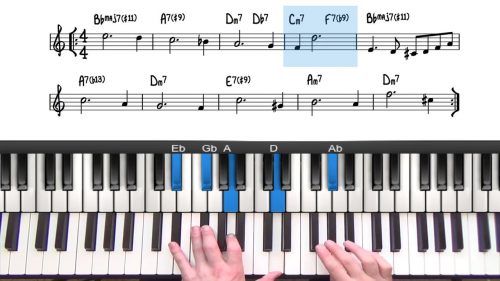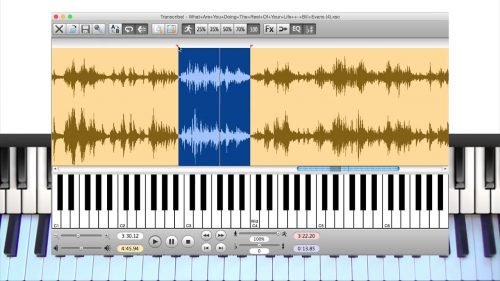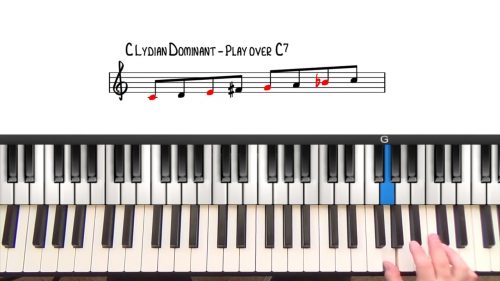Improvising Over Blue in Green
This is a follow up to the first Blue In Green Tutorial Lesson. Watch this lesson first to become familiar with the form and chord changes.
When first starting out improvising, there is the temptation to always be playing. However, if you listen to the masters of jazz you will hear that rests and silence take up a considerable amount of there solo and allow them to take a breather to connect phrases and ideas.
In this lesson we explore a number of general improv concepts that can be applied to any jazz standard:
- Arpeggios
- Extending arpeggios up the scale or mode
- Altered arpeggio shapes over dominant chords
- Approach patterns
- Enclosures
- Turns
- Chord tone soloing
- Note selection… choosing long notes carefully
It’s important to memorise the chord changes before attempting to improvise. You do not want to be looking to the lead sheet whatsoever when trying to as this will consume some of your concentration and make the process of improvising even more difficult.
A great place to start is to use the iReal Pro app and just play left hand voicings until you have committed the voicings to your muscle memory. Blue in Green has a relatively short simply form so there are not a huge amount of voicings to remember.
Lesson Downloads
-
“Blue In Green” Transcription File Type: pdf
-
“Blue in Green” Modal Scale Choices File Type: pdf
-
Melodic Minor Modes Cheat Sheet File Type: pdf
-
Major Modes Cheat Sheet File Type: pdf
Practice Tips
-
When you are attempting to improvise over a jazz standard, it is vitally important that you have completely memorised and internalised the chord changes and the melody.
-
You should not even have to think twice about what chord is coming next. To do this I recommend practicing with the iRealPro App and just cycle around and around the tune with left hand voicings until the chord progressions and voicings almost becomes subconscious.
-
Then you are ready to focus and concentrate on your right hand and explore melodic improvisation. This is important!
- Record yourself improvising and play back to yourself afterwards. It's difficult to subjectively analyse your improvisation whilst playing!








This is an absolutely stunning lesson – I’ve learnt so much from this; my improvising is really improving after following this – there’s a lot here to work on and it will keep me going for ages as I improvise over various other tunes I’m working on. Your demonstration of the main techniques and ideas is really excellent – thank you!
Thanks for the comment Ken – glad you found the lesson useful :-)
Thanks Ken – glad you found the lesson useful. Cheers, Hayden
Hi Hayden,
I’m a new member. You have some great resources. This lesson is great. I would be very helpful if you were to develop more lessons on single line improvisation. I find your player a bit clunky and inaccurate when it comes to pin pointing and replaying parts of the lesson. Transcribe is a fantastic program for precise playback and looping of video and audio. Is there something I’m not doing right with your videos?
Cheers,
Don.
Hey Don, welcome to PianoGroove Pro!
It’s great to hear you are enjoying the tuition and learning resources…. I’d recommend that you check out these other lessons on single line improv if that is what you are interested in:
Firstly, this lesson highlights the importance of resolving your lines and always having a point in mind where you will resolve the tension: pianogroove.com/jazz-piano-lessons/approach-patterns-target-notes/
Next, here is a study on the Altered Mode which is a very useful modal scale for improvising over dominant chords: pianogroove.com/jazz-piano-lessons/altered-scale-improv/
And finally, here’s a lesson on pentatonic scale improvisation which is also known as the “East Coast Sound” – pianogroove.com/jazz-piano-lessons/pentatonic-scale-improvisation/ – pentatonic improvisation is characterised by angular intervals and patters.
Also check out the blues series here: pianogroove.com/blues-piano-lessons/ – we cover a lot of very important principles such as chord tone soloing, chromatic approach patterns, enclosures, and passing tones…. if you’re new to improvisation this should give you more direction.
We will be adding more to the imporvisation tutorials soon.
Yes thanks for highlighting the A/B Loop… I’m currently working on improving the accuracy of this and providing instructions within the player. One issue is the video length, with longer videos, it becomes harder to precisely loop…. my plan is to split longer videos will be split up into shorter ones to help with this.
I hope this helps and any other questions just let me know :-)
Cheers,
Hayden
Thanks for the video. I posted a question after another video about modes and scales. I’m just wondering if there is another way to think about improvising over a tune like this by thinking something like this: “Over the Bb major chord I can play these few modes” and “Over this A7alt chord I can play these modes”. Do you think there is any value in thinking about improvising like that?
Hi Josh, thanks for letting me know… that question has been answered :-)
To answer this question:
What you are outlining is the first step towards improvisation. This is the theoretical understanding of the scales that work well with the corresponding chords.
Remember that these are just an ‘available pool of notes’ and you can (and should!) also play notes that are not in the mode. This can be achieved by adding chromatic passing tones, approach patterns, enclosures etc…
The notes that are not in the mode will often sound very dissonant and these can be used to add interest to your lines.
My main recommendation would be to listen and transcribe from your favourite versions of this tune.
From your question, it sounds like you have a good understanding of the modes that can be used over different chord types, and so this will give you the foundations for analysing and understanding what the great players are doing in their solos.
You can’t play this music with conviction unless you spend the time to listen. You should be listening to jazz everyday.
When you come to improvise, this is something very personal to you, to the players that you have listened to, and the sounds that you are hearing in your head when you take a solo.
Improvisation is the process of spontaneous composition. You are calling upon sounds and musical ideas that you have absorbed from listening and transcribing. One does not simply ‘pluck ideas out of thin air’.
This is why listening is so very important for every jazz piano student.
I would recommend that you check out the course on Transcription: pianogroove.com/jazz-piano-lessons/how-to-transcribe-lines-solos/
The beauty of transcription is that you have complete control over the direction of ‘your sound’. You will have your own personal tastes and preferences and this manifests itself from your favourite records, albums and artists.
After spending the time to listen, transcribe and analyse the lines and solos of your favourite players, you will gradually be building up a ‘library of sounds’ in your head that you will then have at your disposal for improvisation.
Understanding the theoretical foundations allows you to take this journey.
Listening, Transcribing, and then Improvising with this material is a very slow and gradual process, but also one that you should enjoy taking. It isn’t easy and it’s very time consuming. Understand and accept this, and then get started.
I hope this helps Josh, check out the course referenced and any other questions let me know :-)
Cheers,
Hayden
Thanks Hayden. I watched this lesson again and have a follow up to my question. I noticed that you never said “this song is in this key”. When improvising over this or any other jazz standard is the key of the song relevant? Thanks.
Hi Josh 👋
This tune is unusual because it’s a modal composition. The key signature is C Major, but I would look at the tune as D Dorian.
The main purpose of the key signature is to make the lead sheet easy to read. Aside from that, it has little additional benefit to the arranger, or improviser.
Something you need to understand…
When playing a single jazz standard, you will modulate through many different keys, and so the ‘key centre’ is always changing. Jazz standards typically start and end in the same key, but often modulate elsewhere in the bridge and throughout the form.
As mentioned, this is an unusual tune, but if you check out other jazz standard tutorials, particularly ones with 32 bar forms, you will find that there are 251s in many different keys. That is the harmony modulating. You will see patterns, for example, a common movement is the I chord tuning minor in a 251 progression and this then becomes the II chord of a 251 a whole step down (Think of “Tune Up” in the foundation course). Another common modulation is to neighbouring keys in the circle of fifths because they are harmonically very similar.
Because of this, you should always be analysing what key you are in to help you with improvisation.
Also look out for other progressions, such as the I-VI-II-V or the III-VI-II-V-I which can help you analyse the key changes in a tune. Check out this course for more info on those progressions: pianogroove.com/jazz-piano-lessons/intros-endings-turnarounds/
I hope this helps Josh… any questions let me know.
Cheers,
Hayden
Hi Hayden,
I see that, in the improvisation at the very beginning of the lesson, especially in the second run, you simplified the changes by playing in the left hand one instead of two chords – as for instance Dm7 without the following Db7. Also, in the second run, I noticed that you played E7(#9) identical as Db7 in the third round (F – B – Eb). Is this simplification a part of making it more modal or there was another idea behind?
A good lesson! I must say that I also lack more material on melodic solutions for improvisation. There is a lot about harmony and not enough on melodic patterns, principles and choices. It would be great if you add these in future.
Hi Simke,
This is an interesting tune to explore modal soloing and improvisation. The idea is to encourage students to visualise and experiment with modal scales and the interesting colours and tensions in these scales.
It’s common to simplify chord changes when improvising, but make sure that you stick to the form of the tune (10 bars in this case).
In terms of melodic patterns, principles, and choices…. much of this is based on music i’ve listened to. This is a gradual process where you will absorb phrasing and melodic ideas through repeated listening and transcription.
Improvisation is very personal based on the music you have listened to and transcribed from.
My recommendation would be to check out the course on Transcription: pianogroove.com/jazz-piano-lessons/how-to-transcribe-lines-solos/
This is the start of “stage 2 jazz education” where your sound and melodic ideas are a manifestation of the records, artists and albums that you have spend time listening to, and transcribing from.
I hope this helps give you some direction, if I can be of further assistance just let me know :-)
Cheers,
Hayden
Hi Hayden,
I was wondering how should I use the sustain pedal while playing this piece (and to some extent, all other jazz pieces). Do you use sustain pedal at all either when playing or when improvising? Should you release+step on the pedal on every chord change? Thanks.
Paul
Hi Paul 👋🏻
Great question!
As this piece is often performed as a ballad, the sustain pedal can be used quite liberally when playing the voicings. The harmony of the piece does lend itself well to the sustain pedal to create a nice blurred and lingering effect which is somewhat true to the title of the tune “Blue In Green” where I imagine blurring colours together.
I use the sustain pedal much less when improvising because it can be easy to blur our melodic lines. This is particularly true if we are playing at faster tempos where in some cases it’s best to avoid the sustain pedal completely.
It can also depend on the context, if I was playing this tune as a solo piano ballad for example, I would likely use more sustain pedal than if I was playing it up-tempo in a trio setting.
Finally, for your question on releasing+step on the pedal for every chord change. I just played through the tune solo piano ballad style, and yes I do releasing+step on the pedal for every chord change.
Even when playing solo piano, I like to bring up the tempo when I improvise melodies over this tune and I find that I then lay off the sustain pedal which makes my left hand voicings a little cleaner, and my melodies a little sharper. I still use the sustain pedal, but not as much as when playing at slower tempos.
I find this brings more clarity to what I’m playing as it can be very easy to blur both melodies and left hand chords when playing at faster tempos.
I recently answered a similar question in the forum on using the sustain pedal, you can see it here: pianogroove.com/community/t/the-nearness-of-you-stunning/3178/5
I hope this helps Paul and enjoy playing with this beautiful tune.
Cheers,
Hayden
Why is Dm7 chord (left hand) played as F-A-C-E vs. D-F-A-C? Thank you. KE
Hi Karen,
Good question!
This is a rootless voicing where we omit the root of the chord and include other more colourful tones, in this case the 9th which is E.
If this concept is new to you, check out our course on extended chords where we explore the theory and application: pianogroove.com/jazz-piano-lessons/left-hand-voicings/
Here to help if you have any further questions.
Cheers,
Hayden
Hayden, that was an incredible teaching session! It answered so many questions about improvisation with each concept building upon the one before. I’ll rewind this lesson many times in the next few months. It hits the “sweet spot” between understanding left hand voicings and beginning to understand their possibilities on the right.
“imposing boundaries and restrictions are important so you do not become overwhelmed by all the possibilities and options available to the improvisor” – a deja-vu moment. I’ve been there many times!
Thanks,
George
Thanks George – I’m really glad you enjoyed the lesson.
For improvisation, listening and transcription is very important.
I explain more in this video: pianogroove.com/community/t/the-importance-of-listening-transcribing/2737/ and also check out Jon’s video here where he explains the benefits of transcription: pianogroove.com/blues-piano-lessons/tips-insights-from-jon/ – transcription is hands-down the best way to improve our ability to improvise.
The ear training exercises in the forum are invaluable to get your ears up to speed – pianogroove.com/community/c/improvisation-exercises/30 .
You might also like to check out these transcription exercises and analysis:
– pianogroove.com/community/t/wynton-kelly-transcription-exercises/3810
– pianogroove.com/community/t/bud-powell-transcription-exercises/4394/
– pianogroove.com/community/t/red-garland-transcription-exercises/4101
– pianogroove.com/community/t/thelonious-monk-transcription-exercises/4319
If you are new to transcription, start by spending 15 minutes on the Transcription Exercises each day and gradually increase this. Always come back to revisit it after sleeping on it as often the development happens when we are sleeping.
Hope this helps George and here to help if you have any further questions.
Stay safe and enjoy the lessons!
Cheers,
Hayden
Hello Hayden,
I noticed in the portion where you explain the use of extended chord tones during improvisation (at about 13:10), you mention that you like to use the 9th when “the melody falls stationary” yet proceed to play the #11th during Bbmaj. Was this a mistake or is the actual example of the use of the 9th in the beginning of bar 3 when playing Dm7?
I might just not be understanding exactly what is being referred to by using extended chord tones “when the melody falls stationary” or them being “notes to hang around on”? Would you be able to explain? Maybe I could better interpret the example once that is clear. Thanks and great lesson as always!